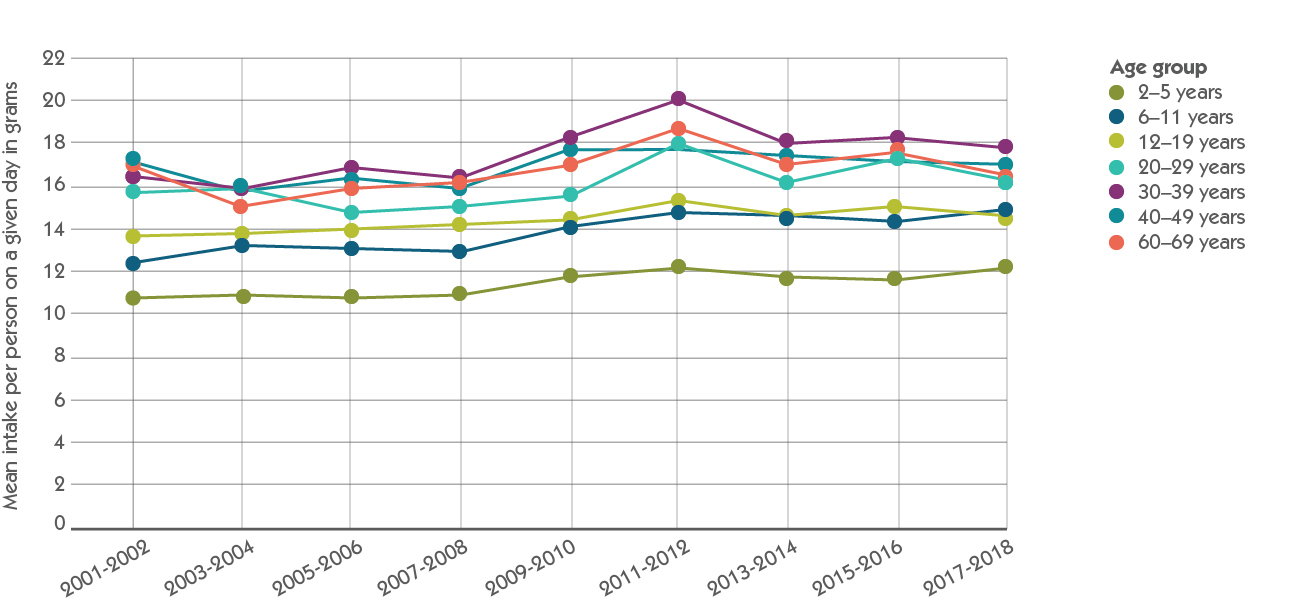

Generational Fiber Gaps
Dietary fiber is important for all life stages, contributing to overall health and well-being through digestive health, immunity, cardiovascular health, weight management and more. Depending on age and sex, dietary reference intakes for fiber vary.1

Although dietary fiber is a crucial nutrient that plays a role in healthy lifestyles, most of the population falls short in their fiber consumption.
Dietary Fiber Gap
Despite these recommendations, most Americans consume significantly less fiber. In fact, the Dietary Guidelines for Americans (DGA) state that fiber is one of the dietary components of public health concern because of underconsumption, even in children.
- During the second year of life, dietary fiber is one of four nutrients of public health concern for underconsumption (vitamin D, calcium and potassium are the others).
- For adults, the percentage of the population not consuming enough fiber is great: More than 90% of women and 97% of men do not meet recommended intakes for dietary fiber.1
- Data from the National Health and Nutrition Examination Survey showed that average dietary fiber intake for all age groups fall short.2

Effects of Underconsumption
Inadequate dietary fiber consumption is called out in the DGA because low intakes are associated with several health concerns. Fiber contributes to a healthy gut microbiome, satiety, digestive regularity, blood sugar control, cholesterol and blood pressure maintenance, and more. Because fiber plays a role in overall wellness, each age group may be missing out on fiber’s benefits for age-related health areas.
- Children
- Digestive health
- Microbiome
- Adults
- Weight management
- Digestive health
- Cardiovascular health
- Microbiome
- Seniors
- Digestive health
- Cardiovascular health
- Microbiome
Fibersol® Helps Close the Fiber Gap and More
Focusing on fiber is a dietary effort for 39.59% of consumers, indicating a significant interest in fiber-rich foods.3
Food manufacturers can help close the fiber gap by offering fiber-enriched products—simply by adding Fibersol® to their formulations.
Backed by over 30 years of clinical research, Fibersol® is not only a source of well-tolerated prebiotic dietary fiber, it also offers other wellness and formulation benefits.
Fibersol®’s Science-backed Benefits
- Well-tolerated prebiotic - At 15g per day (3.75g of Fibersol®-2 4x per day), Fibersol®:
- May help nourish the intestinal flora and maintain a healthy intestinal tract environment*
- Supports front-of-pack claims “Contains/ provides prebiotic fiber” on products with 3.25+g Fibersol®**
- Supports “Well-tolerated prebiotic” on applicable products
- Satiety/GLP-1 claims - At 10g of Fibersol® with a meal, Fibersol®:
- May delay hunger
- May stimulate appetite-regulating hormones
- May increase GLP-1 as part of a normal physiological response in healthy individuals
- May increase satiety perception
- Gut microbiome - At 15g per day (3.75g of Fibersol®-2 4x per day), Fibersol®:
- May help nourish the intestinal flora and maintain a healthy intestinal tract environment*
- Post-meal triglycerides - At 5-6 g of Fibersol® with each meal, clinical studies have shown that Fibersol®:
- Helps attenuate the rise in blood triglycerides following the meal that are within the normal range in healthy individuals
- Helps retain healthy triglyceride levels
- Post-meal blood glucose and insulin - At 4-6 g of Fibersol® with each meal, clinical studies have shown that Fibersol®:
- Helps reduce blood sugar levels/minimize blood sugar spikes after a meal that are within the normal range in healthy individuals
- Helps reduce blood insulin response/the rise in blood insulin after a meal that are within the normal range in healthy individuals
- Digestive health - At 4-8g per day (for 2 weeks), Fibersol®:
- Helps support/maintain intestinal regularity
- Helps relive occasional constipation
- May support gut health
- Improves stool consistency
Fibersol® provides the solution for helping people of all ages meet their fiber requirements.
Case Studies
Blueberry Acai Muffin & Ancient Grain Streusel
Birthday Cake Pea Milk
Vegan Mint Chocolate Chunk Frozen Dessert
Power Packed Apple Cinnamon Bites
Cranberry Limeade Prebiotic Sparkling Water
Sources:
1The Dietary Guidelines for America, 2020-2025. Dietaryguidelines.gov
2NCHS Data Query System. Dietary fiber intake [Internet]. Hyattsville (MD): National Center for Health Statistics; c2024. Available from https://www.cdc.gov/nchs/dqs
3Kantar Profiles/Mintel, Nov 2024
* For a total of 15g per day over 3 weeks
** 2.8g fiber from Fibersol®, corresponding to 10% DV for fiber

